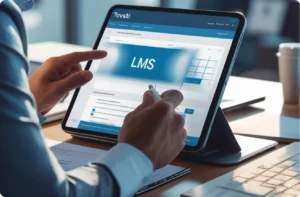Here are online modules meaning: E-learning modules are adaptable building blocks for modern training. Each one is a self-contained lesson that can take the form of an interactive quiz, a branching scenario, a simulation, an assessment, or a short video with embedded checks. They are among the most versatile elements of the online learning landscape: you can collect them into a compact app for a small number of enthusiasts or build an ecosystem for an enterprise.
This guide helps you see what a learning module is, where modules matter, and how to make them work. You will get:
- A clear definition of what a module is and how it differs from passive content
- A practical lens for deciding when modular learning outperforms classroom-only formats
- A simple map of implementation paths across LMS platforms, CMS integrations, and standalone delivery
- Real-world snapshots from Starbucks, Deloitte, Sky, and Harvard Business School that show how specific module types translate into measurable results
- A concise view of AI’s role in creation and delivery, from auto-generated quizzes and translations to personalization and adaptive paths
As an e-learning app development company with over 14 years of experience building education platforms, AnyforSoft has witnessed the power of well-designed modules firsthand. Such modules consistently shorten time to productivity and raise completion rates across diverse teams.
A good example comes from Wittenborg University of Applied Sciences, where AnyforSoft rebuilt the institution’s learning website around a modular architecture. That same principle of modular design drives modern e-learning: flexible components, consistent structure, and scalable growth.
Understanding how modular thinking shapes training begins with the foundation itself—what an e-learning module is and how it works.
What Are E-Learning Modules?
Modules turn a topic into a small, teachable experience with a clear finish line. Each piece has a job: a goal to aim for, material to learn, practice to apply it, and a quick check that learning is stuck.
Think of a module as a recipe card for building one capability. It names the result, gathers the right ingredients, and guides the learner through steps that lead to a reliable outcome. The clearer the objective, the better the design choices you will make.
The essential pieces of a solid module are:
- Learning objectives — specific targets that define success.
- Content assets — text, video, audio, and visuals that deliver the material.
- Interactive activities — exercises, simulations, or scenarios that turn knowledge into action.
- Assessments — short quizzes or tasks that confirm understanding.
- Feedback — immediate explanations that reinforce the right moves.
- Progress tracking — completion and performance records for visibility.
The following features differentiate a module from generic content:
- It forms a complete learning unit from start to finish.
- It requires active participation.
- It produces evidence of learning.
- It can be reused with new cohorts.
- It travels across platforms through standards like SCORM or xAPI.
The size and scope of a module should match the specific skill or capability it’s meant to build. Keep focus tight. Each module should target one clear outcome, whether it’s a five-minute micro-lesson or a two-hour session with natural breakpoints.
E-Learning Module Examples: Types, Uses, and Real-World Applications
Online modules come in distinct formats aligned to specific objectives and contexts.
Microlearning modules
Microlearning focuses on one idea at a time. Lessons run 3 to 10 minutes and deliver just-in-time knowledge on any device.
A microlearning module narrows scope to a single outcome. To achieve this goal, it uses lightweight media like short video, infographics, or quick quizzes, and encourages immediate application. The result is fast uptake without pulling people away from work.
Real-world examples of microlearning in action include:
- Starbucks. Training covers new drink recipes, customer service steps, and equipment care. Modules are available on mobile, so employees can learn during natural breaks in their day. Many lessons include brief simulations or role-play prompts to reinforce behavior.
- Deloitte. Consultants get targeted refreshers on data analysis, presentations, and project management. Short videos, articles, and mini case studies lead into quick checks to confirm understanding. The modular format supports rapid upskilling between client tasks.
- Accenture. Staff learn emerging tech like AI, blockchain, and cloud through short, interactive courses. Drag-and-drop tasks and coding challenges increase engagement and retention. Adaptive platforms tailor each path to close individual skill gaps.
Together, these examples show how microlearning delivers fast, focused learning that scales across teams with minimal disruption to the workday.
Scenario-based modules
Scenario-based modules place learners inside realistic situations where each choice has impact. When combined with gamification in E-learning, these modules further boost engagement and knowledge retention through challenge and reward dynamics.
A typical flow presents a situation, offers plausible options, and reveals outcomes with immediate feedback. Learners practice tough conversations, customer resolutions, management calls, or ethical decisions in a safe space that mirrors work. By cycling through branches and debriefs, they see how different paths produce different results—and how to choose better next time.
One strong example is LRN Corporation, which trains more than 30 million people across 2,500+ organizations each year on ethics and compliance using immersive, gamified scenarios. The result is higher completion, stronger comprehension, and more consistent, compliant decisions.
Assessment-driven modules
Assessment-driven online learning modules verify that learning happened. Learners move through questions or practical tasks, receive immediate feedback, and see exactly where to improve.
Typical formats include:
- Multiple choice.
- True/false.
- Matching.
- Fill-in-the-blank.
- Hands-on or practical exercises.
A practical example comes from High Pass Education, where AnyforSoft built an assessment platform for mental-health certification prep. The system provides section-level subscores, per-question explanations, time-per-question analytics, and progress across multiple attempts—giving learners targeted feedback while administrators see item difficulty, common errors, and completion times. The result is verified skill evidence at scale and a data-driven loop to improve exams and content.
Interactive video modules
These E-learning training modules combine video instruction with interactive checkpoints and decision moments. Learners watch, respond, and apply in sequence, which suits complex topics where demonstration plus practice drives mastery.
Typical components include:
- Embedded quizzes that check understanding without leaving the video
- Clickable hotspots that reveal definitions, policies, or tooltips in context
- Branching decisions that change the storyline based on choices
- Short assessments that confirm skills at the end of a segment
Consider Deloitte, which trains employees on ethics and compliance with interactive videos that accept real-time input. Clickable hotspots, branching scenarios, and in-video quizzes keep attention and reinforce policy decisions, leading to higher completion and better recall than passive viewing. Deloitte also varies production styles, using animated explainers, whiteboard sequences, simulations, and scenes with actors, and in some cases extends into AR or VR when the topic benefits from immersive practice.
Professional development modules
Professional development modules build job-ready skills through structured courses that combine explanation, hands-on practice, projects, and assessment. This type of module follows a simple arc: teach, practice, prove, apply. Each element moves the learner from concept to on-the-job performance, with progress recorded and recognized.
When these modules follow best practices for accessibility in E-learning, they ensure every learner, regardless of ability or device, can fully participate and achieve the same outcomes.
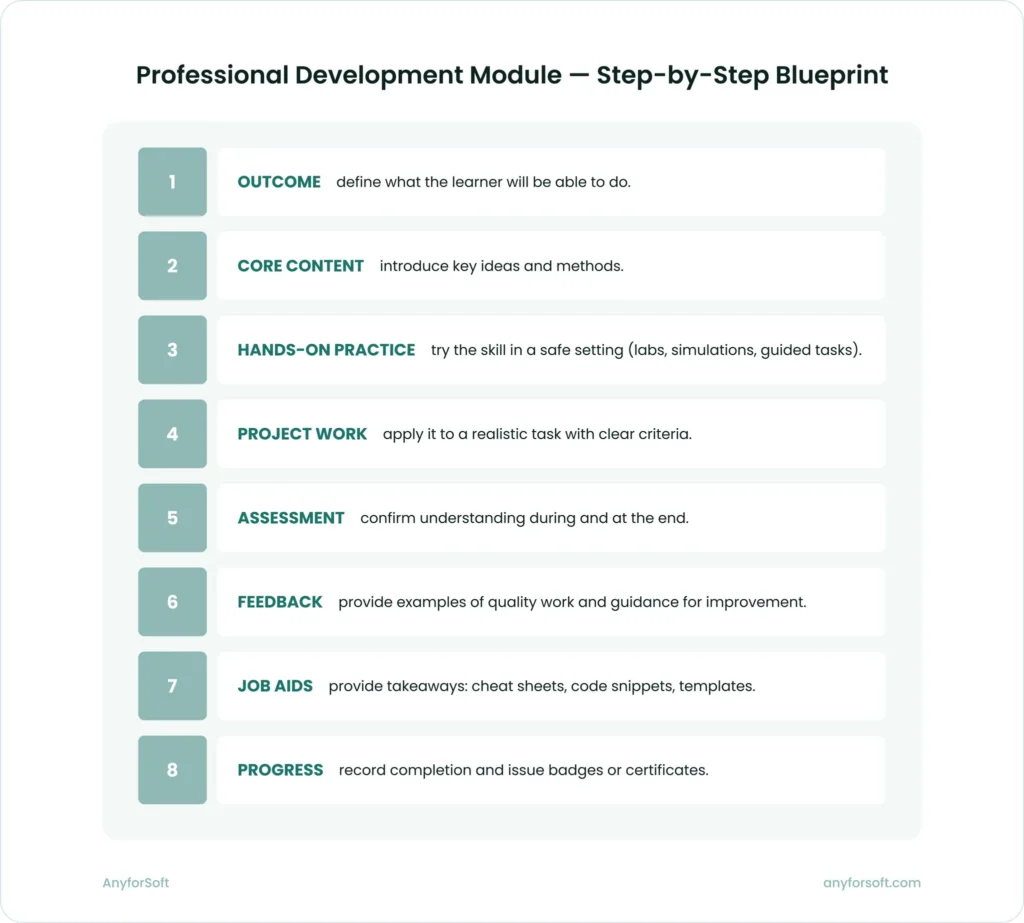
Google Career Certificates demonstrate the professional development module blueprint at scale, with over one million graduates globally. Each certificate program combines video lessons, hands-on labs, and capstone projects that build portfolio-ready work examples. Learners progress at their own pace through structured modules and earn credentials recognized by 150+ employers, with over 70% of U.S. graduates reporting positive career outcomes within six months.
Large-scale professional course modules
Large-scale academic and professional course modules are the most comprehensive form of e-learning. They replicate full certification tracks in a digital format and run for weeks or months. Each program bundles core elements, such as video lectures, readings, assignments, peer discussion, and exams. All of them run in a paced sequence with clear milestones and progress tracking.
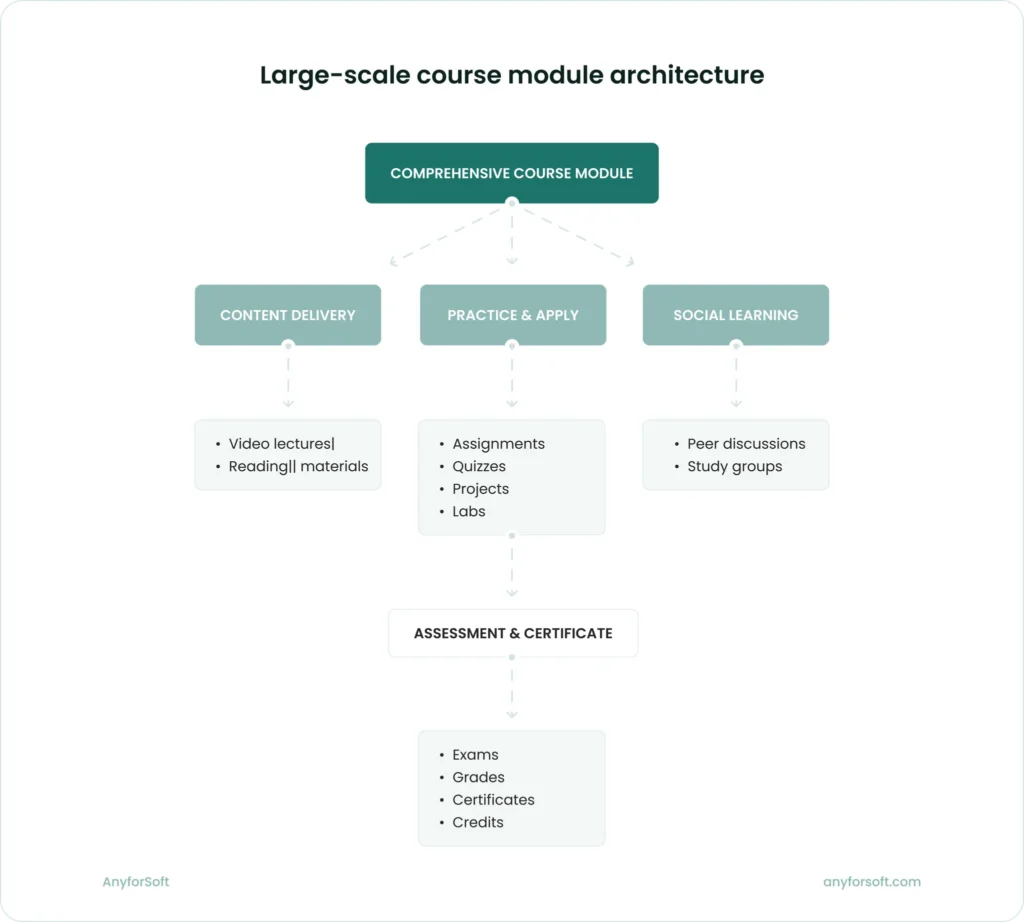
Coursera is proof that this model scales worldwide. Courses from institutions such as Harvard, Stanford, and MIT run on its standalone web and mobile apps, serving 175 million users globally. Learners progress asynchronously through faculty videos, graded work, and peer discussion, earning certificates or full degrees entirely online.
Now that the main module types are clear, the next question is where they deliver the most value.
When E-Learning Modules Win: Strategic Advantages for Specific Scenarios
Modules deliver their strongest returns in well-defined situations. Knowing where they outperform helps you invest training time and budget with confidence. Here, traditional methods refer to live instructor-led sessions, workshops, and mentoring or shadowing, delivered online or in person.
When you need to train at scale (50+ people or more)
Scale changes the math: one well-built module can train 20, 200, or 20,000 people with the same creation effort.
These are the situations where modules win at scale:
- Multi-location organizations that must deliver identical training across branches and sites
- Rapid-growth teams onboarding ten or more new hires each month
- Seasonal workforce surges that require quick ramp-up without scheduling bottlenecks
- Global teams spread across time zones where live sessions exclude someone
- Franchise operations that depend on a uniform brand experience
Traditional methods can still be the better fit for very small groups. When the audience is under twenty people and relationship-building is the primary goal, live instruction gives space for discussion, immediate coaching, and context-specific nuance that a standardized module does not provide.
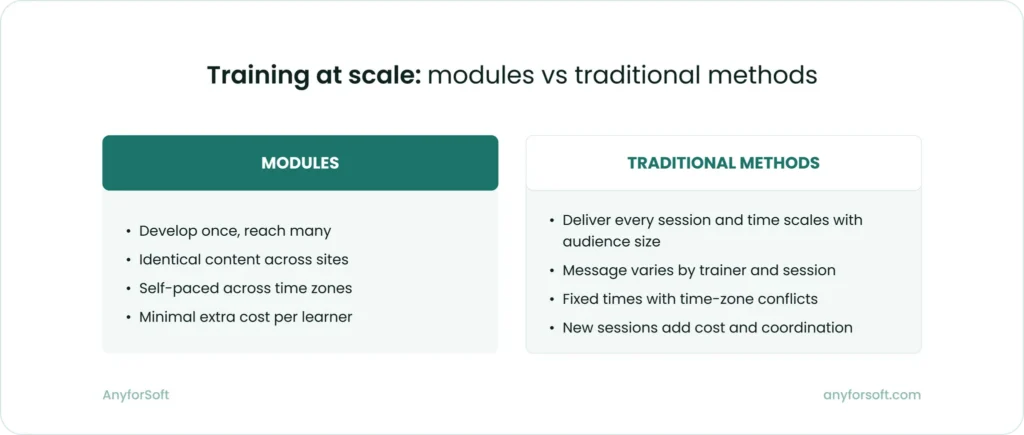
When you need proof of completion and knowledge verification
When outcomes must be documented and defensible, modules excel by generating automatic, audit-ready records of who learned what and when.
These are the cases where modules win on verification:
- Regulated industries such as healthcare, finance, or manufacturing that require documented compliance with traceable audit trails
- Certification paths that demand verified assessments before credentials are issued
- Safety-critical topics where proving competency reduces organizational risk
- Mandatory annual training (harassment prevention, privacy, ethics) with completion tracking and timed renewal reminders
- System access that requires proof of training before permissions are granted
- Performance improvement plans that need clear evidence an employee received and completed assigned training
Traditional methods still work when documentation is optional and the process itself is the outcome. Executive coaching, cultural integration, and creative skills often benefit from live dialogue, observation, and iterative feedback, where relationship depth matters more than formal pass–fail records.
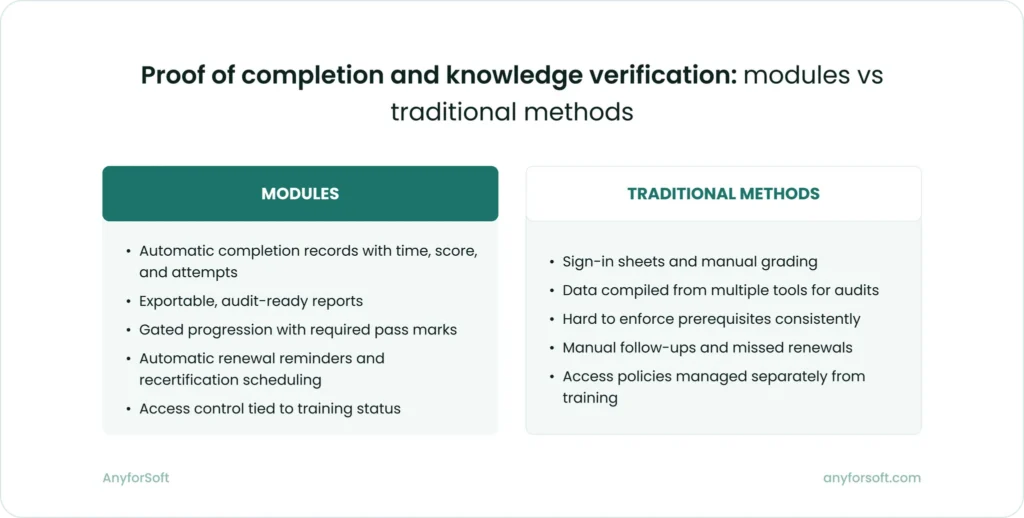
When you need consistency across locations, shifts, or time periods
When training must be the same everywhere, modules deliver a single, updateable source of truth that plays identically for every learner.
You win with modules in situations like:
- Quality control environments where deviations create defects or safety risks
- Brand standards in retail, hospitality, or franchises that demand uniform customer experience
- Multi-shift operations that cannot wait for scheduled sessions
- High-turnover teams that require constant onboarding without exhausting trainers
Traditional methods can be stronger when local context matters more than strict uniformity. Cultural integration, region-specific sales nuances, and relationship-heavy work benefit from live discussion, real examples from the field, and rapid tailoring by an experienced instructor.
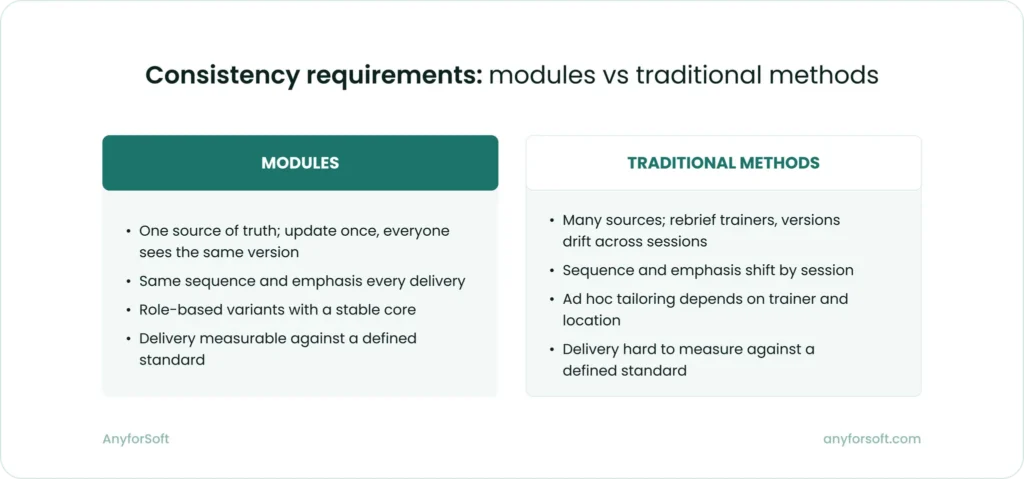
When you need 24/7 availability and self-paced learning
Schedules rarely line up; modules meet learners when they are ready.
You win with modules in situations like:
- Global teams across time zones where a single meeting time excludes someone
- Just-in-time needs when information must be available immediately
- Mixed prior knowledge where some need ten minutes and others need two hours
- Field and mobile roles that cannot attend office-based sessions
- Neurodiverse learners who benefit from controlling pace and environment
Traditional methods work best when real-time collaboration drives outcomes. Cohort workshops, live studios, and problem-solving labs use synchronous interaction, peer accountability, and facilitator feedback to build skill through shared practice.
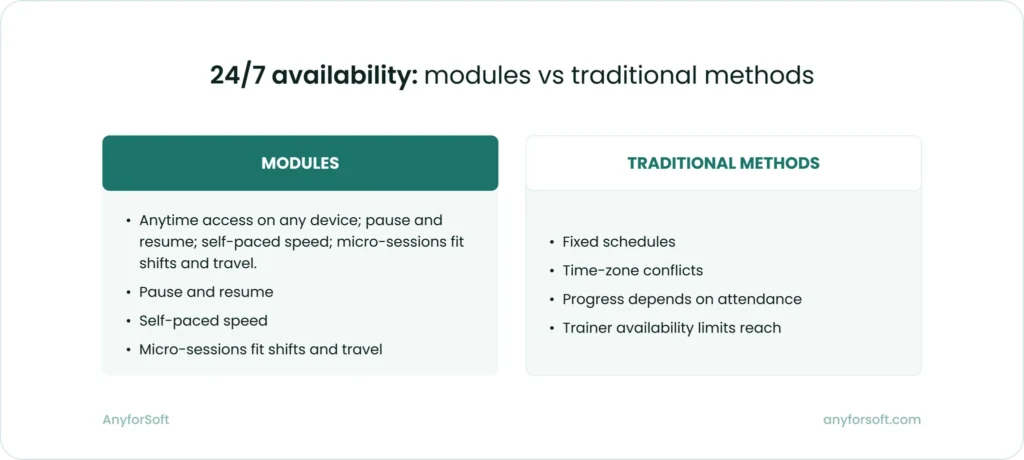
When budget constraints make repeated training sessions impractical
When budgets are tight, a single build that serves many cohorts changes the cost curve.
These are the situations where modules win on cost:
- Frequent onboarding that would consume manager time every month
- Product knowledge updates released quarterly
- Annual compliance renewals across the whole organization
- Skills refreshers required to maintain competence
- Customer or partner education that cannot justify instructor time
- Lean teams where training staff cannot scale to demand
Traditional methods can be the better choice for one-off, specialist topics and very small groups. If the audience is under twenty people or the instructor’s expertise is the main value, a focused live session keeps costs contained and maximizes interaction.
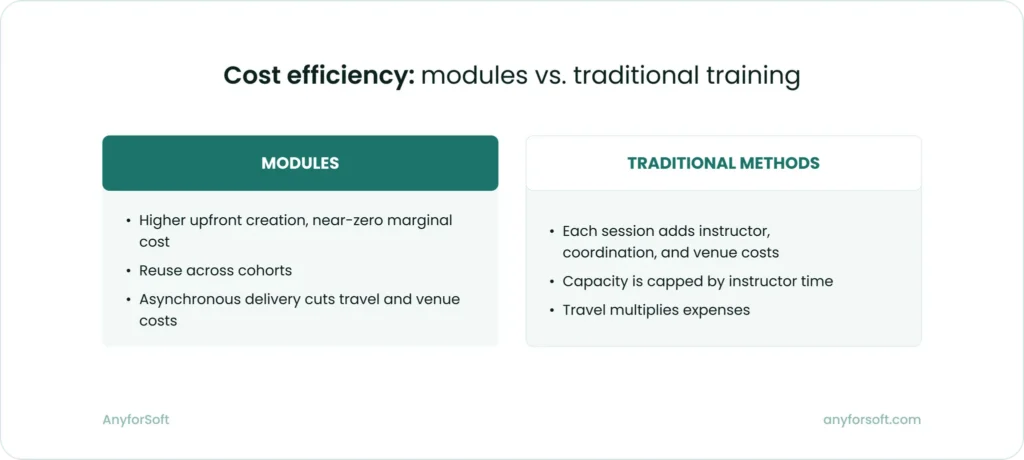
When content changes frequently and updates must deploy quickly
When the message moves fast, centralized modules keep everyone current.
You win with modules in situations like:
- Regulated fields where requirements change and training must update immediately
- Technology products that ship new features continuously
- Policy shifts that need same-day communication
- Crisis or market events that require rapid guidance
- Software interface changes that demand refreshed walkthroughs
Traditional methods are appropriate when content is stable for years and update agility provides no advantage. If the material rarely changes, a periodic workshop or masterclass can meet the need without building a full module library.
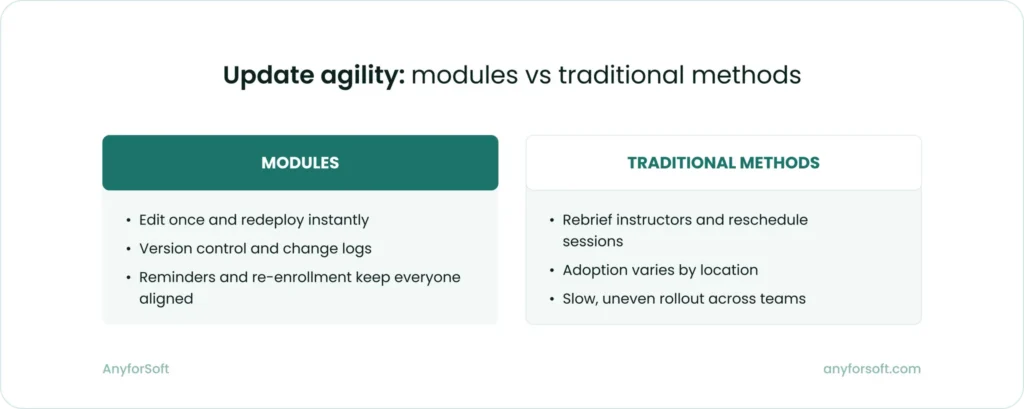
You have the where and why of modular training. Next, let’s see how organizations deploy modules across platforms and workflows to solve specific training tasks at scale.
E-Learning Modules: Flexible Deployment Across Platforms
Modules are portable learning units. Treat them as content packages that travel well: they plug into different delivery systems without losing structure or data, which protects your investment if platforms change. This portability is what turns a single build into many deployments.
In practice, organizations mix four delivery modes to fit context:
- LMS-integrated. Modules live inside the learning platform and inherit governance, reporting, roles and permissions, certification workflows, and HR data sync—an approach often used by top solutions featured among the best E-learning platforms for business. Administration happens from a single console and learning paths stay consistent across cohorts.
- Standalone web. A simple site serves the module at a URL with minimal setup and straightforward distribution to broad or mixed audiences. Access rules can be as light as a link or as controlled as a password.
- CMS/intranet. The module sits where employees already work, inside SharePoint, Drupal, or WordPress. It appears next to policies and SOPs, so lookups and updates feel natural. Search and permissions come from the existing portal, which keeps the experience familiar.
- Mobile delivery. A mobile app or mobile-optimized site carries the module into the field. Offline download, notifications, and device features such as camera or GPS support practice in real contexts.
- Standards (SCORM, xAPI). SCORM packages the lesson so it plays in many systems, while xAPI records activity wherever it happens. Together they make content portable and the data continuous, so one build can move across platforms over time.
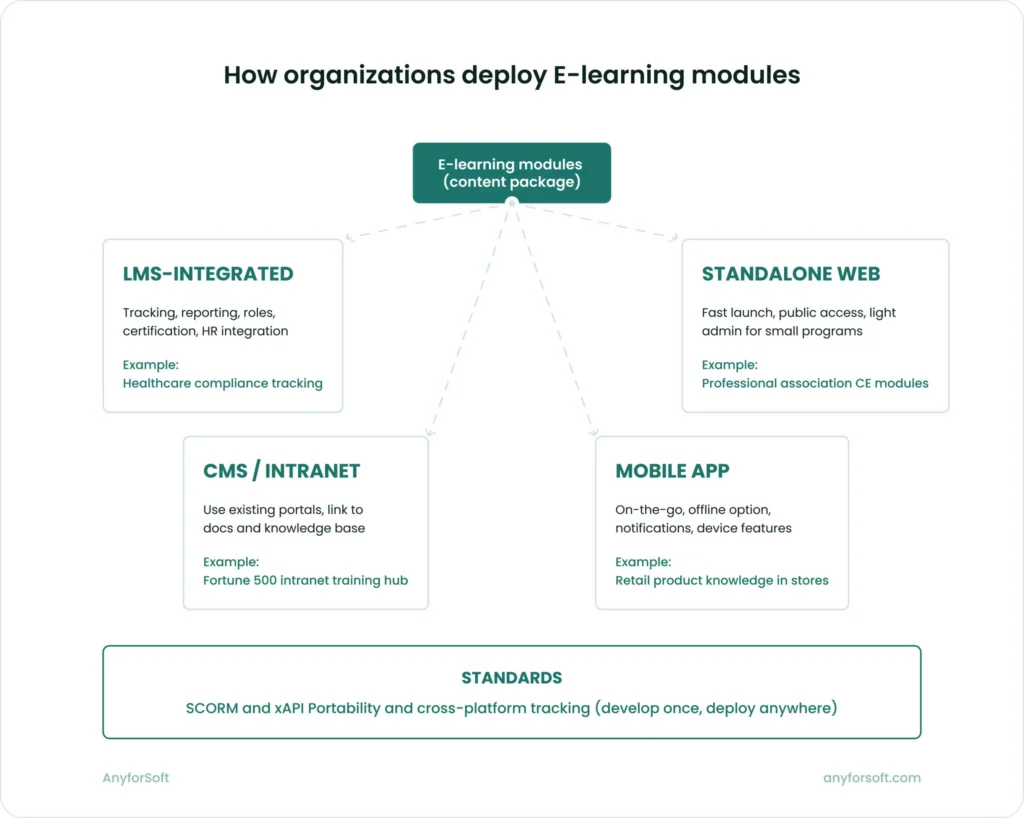
With deployment options mapped, the next step is the work they accomplish. Let’s walk through the core organizational tasks and the module patterns that move each one.
Key Organizational Tasks That Modules Handle
Modules align to real work: they package knowledge, practice, and verification around the jobs teams do every day. The sections that follow connect common organizational tasks to module patterns that deliver consistent, measurable results.
Onboarding new employees
Surveys link effective onboarding to measurable gains: higher retention by 52%, faster time to productivity by 60%, and better customer satisfaction by 53%.
New hires need a reliable path through company basics, policies, tools, and the first set of role skills. In many teams that path depends on who has time, which creates gaps and mixed messages.
A modular onboarding sequence creates a single, updateable route for every hire. New employees move at a comfortable pace, managers see progress and results, and each cohort gets the same baseline regardless of start date or location. Completion records and short checks confirm that essentials were covered.
Typical modules in an onboarding path include:
- Company story, mission, and values
- Organization map and key contacts
- Benefits and enrollment walkthroughs
- Workplace and data policies
- Systems access and first-login tutorials
- Role fundamentals and day-one tasks
With the foundations handled consistently, managers focus on relationship building and job-specific coaching while new hires reach productivity faster and with fewer follow-ups.
Compliance training
For compliance training, modules ensure people complete the course, their understanding is verified, and audit-ready records are stored.
They achieve this through:
- Scenario-based lessons that turn regulations into everyday decisions, improving recall under pressure.
- Built-in assessments with required pass marks that confirm understanding.
- Automated tracking that records who completed which module and when, including scores and attempts.
- Centralized updates that publish the latest version to everyone at once.
- Scheduled reminders and automatic re-enrollment that keep certifications current.
By the numbers, organizations that prioritize e-learning report 27% lower training costs and a 23% lift in knowledge retention; mobile-first delivery further raises completion rates by about 29%.
Skills development, upskilling, and reskilling
Modern teams stay competitive when learning keeps pace with work. Leadership consensus is strong on this: make skill updates easy, frequent, and fast.
“From interviews with more than a thousand CEOs across the country, it’s evident that employees need easy, fast, and ongoing skill updates to keep organizations competitive.”
— John Baker, President & CEO, D2L (via D2L Wave)
Modules turn that need into a workable system. They package one capability at a time and guide learners from concept to application with checkpoints that prove progress. People learn in short bursts, practice in safe sandboxes, and return to the flow of work with confidence.
What this looks like in practice:
- Software tutorials with simulations that build muscle memory before anyone touches production
- Process walk-throughs with decision points that surface why each step matters
- Product knowledge lessons with quick checks that confirm understanding in minutes
- Just-in-time access on web or mobile so help arrives at the moment of need
In day-to-day operations the strongest programs sit inside the workflow. An employee searches, watches a two-minute clip, tries it in a guided exercise, records a short check, and moves on. Managers see progress in one place, content updates reach everyone at once, and support queues shrink as practice replaces repeat questions.
Results you can expect includes fewer errors, higher productivity, and a steady rise in capability as upskilling and reskilling become part of daily work.
Product knowledge training
Teams serve customers well when they understand products inside out. Modules distill complex catalogs into clear, repeatable learning that sales, service, and support can use in the moment.
What effective product training modules include:
- Feature and benefit explainers that connect capabilities to customer value
- Competitive snapshots that frame key differentiators
- Use-case scenarios with objection-handling practice
- Regular refreshes as versions change and lines expand
- Short assessments that confirm readiness before customer-facing work
This approach powers sales enablement, customer service onboarding, technical support preparation, and channel partner education with one consistent source of truth.
Leadership development
Growing managers need concepts, practice, and feedback that fit real situations. Modules provide the foundation; coaching and on-the-job application turn knowledge into habit.
A leadership path typically combines:
- Scenario-based decisions in a safe environment with consequences and debriefs
- Core management skills such as delegation, feedback, and conflict resolution
- A blended cadence: modules for concepts, guided coaching for application
Use it to support first-time manager programs, build a leadership pipeline, and align teams to a shared management philosophy.
AI in E-Learning Modules: From Creation to Conversation
Artificial intelligence now shapes every stage of e-learning—from how modules are created to how learners experience them. It accelerates development, personalizes delivery, and, through chatbots, keeps digital learning conversational and responsive at scale.
AI as a framework for module creation and delivery
Artificial intelligence is reshaping e-learning in two distinct places: how modules are built and how they are experienced. You can adopt AI at either stage, or at both, depending on resources, technical readiness, and goals.
Think of AI as a toolkit for two jobs:
- In creation, it drafts quiz questions, first-pass content, translations, voiceovers, and scenario variations, often cutting development time by 40–60 percent.
- In delivery, it adapts paths in real time, adjusts difficulty, tutors when learners stall, and flags where people are likely to struggle.
The key idea is decoupling: you can use AI for creation without using it for delivery, or the reverse. Many teams start with one and add the other later.

Choosing the right lane depends on a few factors:
- Training volume — how many learners or programs you need to support at once.
- Content update frequency — how often your materials must be revised or localized.
- Learner diversity — differences in skills, languages, or learning styles across your audience.
- Infrastructure readiness — the systems and tools you already have in place, such as your LMS, data integrations, and IT capacity to support AI-driven features.
Organizations with limited AI capability often start small, using AI to speed up content creation before. It delivers immediate wins, such as faster content creation, without requiring new delivery tech.
As confidence and systems mature, layering in intelligent delivery can lift completion rates and raise assessment scores through personalization.
Chatbots: the link between creation and delivery
Chatbots extend AI’s role in modular learning by bridging the gap between creation and delivery.
- In the development stage, they act as assistants for instructional designers. Their tasks are to help generate quiz questions, rewrite explanations, or propose scenario variations in seconds.
- During delivery, AI-based chatbots in E-learning become tutors for learners. They answer questions, guide navigation, and personalize support in real time. A chatbot can remind users of deadlines, explain complex ideas in plain language, or even simulate customer interactions.
In short, it keeps the learning experience personal and conversational while scaling to reach many learners at once.
Where chatbots fit
| Stage | Role | Value Added | Example Use |
| Creation | Authoring assistant | Accelerates content development; maintains tone consistency | Generates quiz items or scenario prompts for SMEs |
| Delivery | Interactive tutor | Enhances engagement and offers on-demand clarification | Explains policies in compliance training or guides learners through complex workflows |
| Post-learning | Feedback collector | Captures learner sentiment and improvement suggestions | Gathers input after module completion to refine future content |
Conclusion
E-learning modules give learning its structure and organizations their scale. They make training measurable, repeatable, and adaptable—whether you’re onboarding new hires, ensuring compliance, or building leadership pipelines. They transform learning from an event into a system that works the same way every time.
In practice, organizations gain the most value when they:
- Define the goal before building. A clear outcome shapes everything that follows.
- Match the module type to the task. Microlearning builds speed, scenario-based modules teach judgment, and assessments prove skill.
- Choose the right delivery channel. LMS for governance, intranet for access, web for reach, or mobile for flexibility.
- Use feedback loops. Data on completion, scores, and time spent turns maintenance into improvement.
AI now multiplies these advantages. It accelerates creation, personalizes delivery, and extends the lifespan of every learning asset. Yet, the principle remains the same: technology is most powerful when it serves your people and your goals.
The strongest results come from customizable e-learning modules designed around your organization’s:
- Culture and learning habits – how your people learn and what motivates them.
- Systems and workflows – the tools they already use and how they connect.
- Business goals and compliance needs – what success looks like in measurable terms.
The path from idea to impact starts with alignment — between people, process, and technology. To build e-learning modules that fit your organization perfectly, partner with a team that understands both technology and learning design.
FAQs
Think of an e-learning module as a short, focused learning experience; it’s a complete lesson on a single topic or skill. A module combines a clear objective, structured content, and a quick check to confirm understanding. It can stand alone or connect to others, forming a complete course.
The difference lies in scale and flexibility. Traditional courses are broad, time-intensive, and harder to update. Modules are compact, easy to refresh, and fast to deploy. Because each module handles one clear objective, updates take hours instead of weeks, and learners get only what they need, when they need it.
Almost every sector can benefit, but they shine where training must be consistent, measurable, and repeatable.
- In corporate learning, modules simplify onboarding and performance management.
- In healthcare, E-learning modules ensure compliance through traceable records.
- In retail and manufacturing, they standardize procedures across sites and shifts.
In education, they power microlearning, certification prep, and blended instruction.
Yes, and it’s often the best choice. Custom modules align with your tone, brand, and workflow instead of forcing you into someone else’s template. Our team at AnyforSoft designs and builds modules that integrate with your LMS, intranet, or standalone platform. While developing E-learning modules, we adapt their design and functionality to your goals. As part of our E-learning software development services, we help organizations deliver scalable, measurable learning experiences tailored to their business needs.
Start with what you know best—your learners and your goals. Then add structure around it:
- Learning objectives and audience profile. What must people know or do after training?
- Delivery environment. LMS, intranet, web, or mobile.
- Existing content assets. Videos, manuals, policies, or raw materials.
- Design and compliance needs. Visual guidelines, accessibility, or regulations.
Timeline and budget expectations. Even a range helps set the right approach.
The clearer the inputs, the smoother the build and the closer the outcome to your vision.
Cost depends on scope and interactivity. A short, static module can start around $3,000–$5,000. Interactive, scenario-based, or AI-enhanced modules typically range from $10,000–$25,000+. Add multimedia, translation, or integrations, and the price adjusts accordingly. A discovery phase usually provides a reliable estimate and ensures there are no surprises later.
AI shortens creation and sharpens delivery. It drafts first-pass content, generates quizzes, translates text, and even suggests scenarios or branching options. On the learner side, it adapts difficulty, recommends next steps, and highlights areas for review. Think of it as a co-pilot that speeds up production while keeping learning personal.
Off-the-shelf content teaches general skills; custom modules teach what matters to you. They reflect your systems, your culture, and your metrics of success. When training aligns with how your organization actually operates, people adopt it faster, apply it better, and sustain results longer. Custom development turns learning from an obligation into a competitive advantage.




